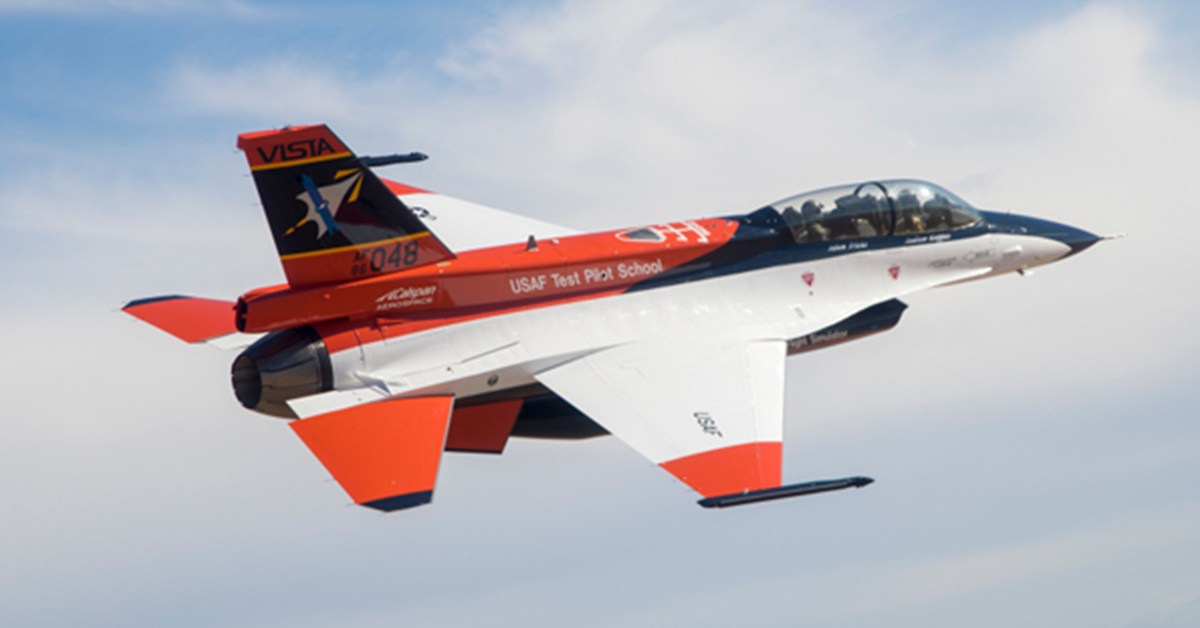The U.S. Air Force is getting serious about equipping its fleet with artificial intelligence and machine learning capabilities amid an intensifying technological competition with China. In one of their most recent AI initiatives, the Air Force successfully tested an F-16 fighter jet equipped with an autonomous agent built by Shield AI.

Curious about the Air Force’s AI efforts? You won’t want to miss the Potomac Officers Club’s 2024 Air Force Summit on July 23! Join this event to hear expert insights from Air Force and industry leaders while staying updated on the latest trends and expanding your network.
AI-Equipped X-62A VISTA Test Scenario
Air Force Secretary Frank Kendall, a 2024 Wash100 Award recipient, was aboard the AI-powered X-62A VISTA — which stands for Variable In-flight Simulator Test Aircraft — during a within-visual-range air combat scenario at Edwards Air Force Base on May 2.
“What we did was we went up and did a number of test points to test out multiple versions of what we call agents that would take control of the airplane and conduct the maneuvering and put us in a position … to automate the engagement that might occur with either a short-range missile or the guns on the aircraft,” said Kendall at an event hosted by the Special Competitive Studies Project earlier this month.
The combat scenario, known as a dogfight, is just one component of the service branch’s overarching efforts to develop autonomous capabilities. Kendall said he was part of 10-12 different scenarios in which he initiated the automation capabilities aboard the aircraft. According to Kendall, the scenario was pretty balanced between human and AI.
“We were up against a pilot who had two or three thousand hours of experience. He was very good. It was roughly an even fight. But against a less experienced pilot the AI … [and] the automation would have performed better,” Kendall explained.
Ultimately, while the AI dogfight test proved successful, Kendall said there is still more work to be done in order for the technology to reach its full potential.
“That technology is not quite ready yet, but it’s making very good progress. We got to see three different versions of it. They all performed, I think, in a way which suggests to me personally very strongly that we’re on the right path and we’re gonna get to where we’re headed,” Kendall said.
Frank Kendall’s AI Efforts
Kendall has long been an advocate of deploying AI in military applications. In June 2023, he requested that the Air Force’s Scientific Advisory Board examine the potential military use cases of generative AI tools like ChatGPT.
Then in December 2023, the Air Force set up an environment for generative AI testing and experimentation within the service branch’s Office 365 environment.
Kendall has also highlighted the need for responsible AI use and deployment, especially on the battlefield.
“The way we should approach is to figure out how to apply the laws of armed conflict to the applications of AI,” he said in December. “Who do we hold responsible for the performance of that AI and what do we require institutions to do before we field these kinds of capabilities and use them operationally,” Kendall, a four-time Wash100 awardee, said during a panel discussion at a forum on Saturday.
AI’s Role in Great Power Competition
AI-powered systems and aircraft offer a number of competitive advantages. First, they don’t have to contend with human emotions as they carry out their missions, making them more resilient.
“They don’t get tired, they don’t get scared, they’re relentless. It’s easy to see a situation where they’re gonna be able to do this job … better than humans can do,” Kendall said of AI warfighting systems.
AI systems are also much quicker and more efficient than human operators, especially in high intensity environments and time-sensitive situations.
“When you get into a complex tactical situation, you get overloaded with the amount of input you’re getting and you’re trying to sort through and decide what to do. You simplify your decision-making process down to the things you need to handle and the basic skills that you have to simplify the problem for yourself. Our computers are not going to have to do that,” said Kendall.
“They’re going to be able to handle that … level of complexity much better than a human can. There are just inherent limitations of human beings. And when we can build machines that can do these jobs better than people can do them, the machines are going to do the job,” he added.



